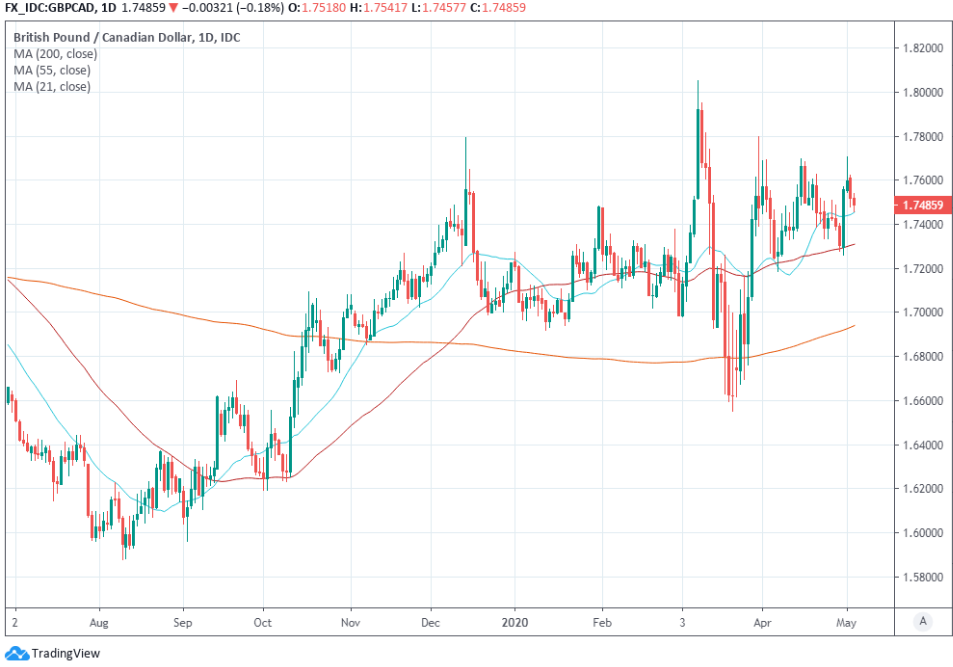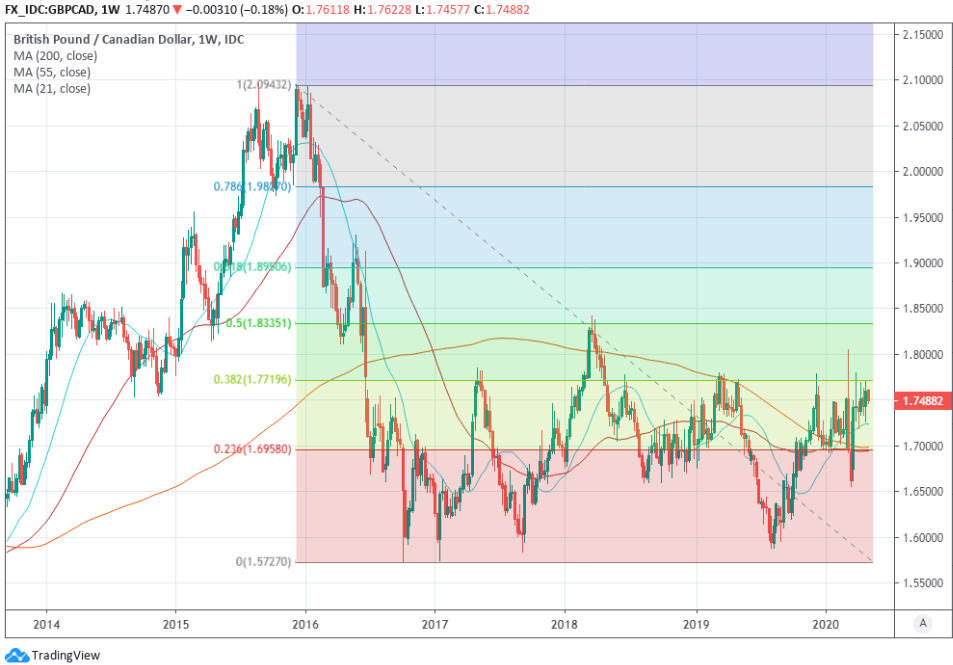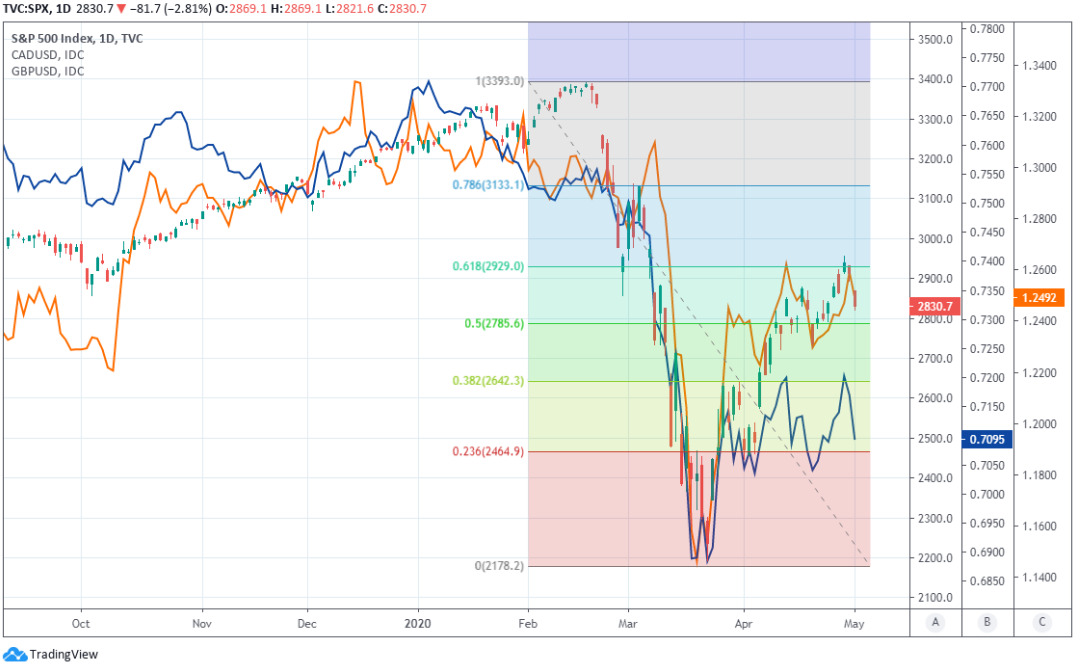The Pound-Canadian Dollar Rate Nears Support and May be Aided by Fresh U.S.-China Tensions
- Written by: James Skinner

Image © Adobe Stock
- GBP/CAD spot at time of writing: 1.7494
- Bank transfer rates (indicative): 1.6882-1.7004
- FX specialist rates (indicative): 1.7232-1.7337 >> Get your quote now
The Pound-Canadian Dollar rate was on course for a second consecutive loss Tuesday but is expected to remain underpinned by a cluster of nearby technical support levels in the coming weeks and could be aided higher if the coronavirus prompts the U.S. and China to come to blows again.
Sterling lagged many of its large counterparts in a risk-on market Tuesday having risen against only the U.S. Dollar, Euro, Swiss Franc and Japanese Yen while ceding ground to commodity currencies like the Loonie as well as Australian and New Zealand Dollars.
The British currency drifted lower against the Loonie but found support on the 21-day moving-average of prices located around 1.7456.
The Pound-Canadian Dollar rate has spent much of the time since mid-March trading between 1.74 and 1.78, after recovering from a low of 1.6545 set amid the height of panic over the coronavirus' advance into major economies, which is effectively the same range that prevailed through much of the final quarter 2019. It remains in a shallow uptrend that began in August last year and is tipped by technical analysts to retain an upside bias in the short-term at least.

Above: Pound-Canadian Dollar rate at daily intervals with selected moving-averages.
"It is hard to trust a signal where follow through is clearly lacking. Trend strength oscillators are bullishly aligned across short, medium and longer term signals and while the shorter-term oscillators are not especially strong, the alignment rather suggests limited downside risk for the GBP for now, we feel," says Juan Manuel Herrera, a strategist at Scotiabank. "We look for support around 1.7350/1.740. We spot major support around 1.69 still."
Tuesday's price action came amid fresh gains for stock markets and oil, with corporate earnings and the easing of 'lockdown' measures in some parts of the U.S. and Europe in the frame. Canada's Quebec province also took its first steps toward normalisation Tuesday, leaping ahead of the rest of the country.
The prospect of life returning to some semblance of normality for the large parts of the global economy has buoyed risk assets for weeks even as investors remain in the dark about the full extent of damage done to economies by the coronavirus, as well as the likely time required for them to recover from it.
Tuesday's gains may also have had to do with the U.S. State Department dialling down rhetoric directed toward China. U.S officials said Monday there'll be no "punitive measures" imposed on China for its handling of the initial coronavirus outbreak so long as the world's second largest economy sticks to the terms of the trade agreement signed in January. This is contrary to the tone of reports that emerged over the weekend and late last week, which had suggested the world's two largest economies could soon come to blows again.

Above: Pound-Canadian Dollar rate at weekly intervals with Fibonacci retracements of post-referendum downtrend.
"Crude oil’s rally continues as more countries and regions move towards easing lockdowns while production cut announcements continue to emerge. Also supporting the market was a report from Genscape saying that the pace of stock build at the Cushing slowed last week. The futures market is looking beyond the coming weeks which remains challenging with regards to lack of storage. Instead, focusing on the recovery phase," says Steen Jakobsen, chief investment officer at Saxo Bank.
U.S. diplomats appeared to contradict each other in on the record comments with Monday's remarks coming in contrast to earlier suggestions the White House would seek to accelerate the removal of international supply chains from China. Monday's remarks don't necessarily preclude the earlier however, and President Donald Trump is clear he believes the virus came from a Wuhan lab near the 'wet market' said by China to be the source of the outbreak.
President Trump, who faces the ballot box in November, alleges China lacked sufficient candour in its disclosures to other countries and says its handling of the problem deprived others of valuable time in which preparations to combat the virus could have been made. The global death toll surpassed 250k this week, with almost half in the U.S. and UK while a substantial majority are to be found split between the U.S., UK and Europe.
"We are becoming increasingly acute to signs of a US/China Trade War 2.0 and the possibility for another US dollar funding squeeze; factors that could very well see USDCAD’s price range resolved with a break out to the upside. Pompeo and Trump turned up the dial a bit over the weekend and the benchmark 3-month EURUSD cross currency basis swap now trades back below zero (-0.50bp)," says Eric Bregar, head of FX strategy at Exchange Bank of Canada.

Above: S&P500 index with Fibonacci retracements of 2020 downtrend, alongside GBP/USD (orange) and CAD/USD (blue).
Sterling and the Loonie have almost a matching correlation with the S&P500 and other barometers of risk appetite, hence the limited range-trade in the Pound-Canadian Dollar rate over the last few months. Both currencies have been heavily impacted by the sudden economic stoppage brought on by the coronavirus, while collapsing oil prices have posed as an additional headwind to the Canadian Dollar while Brexit has begun to haunt the British Pound again.
The global coronavirus calamity and additional unique headwinds faced by Sterling and the Loonie have left the Pound-Canadian Dollar rate in a need of a fresh catalyst on one side of the exchange rate or the other in order to break the 2020 range and a fresh bout of U.S.-China trade tensions just might fit the bill. The U.S. Dollar benefited from the 2018-2020 trade war but only because the tariff fight imperilled the global economy and drove safe-haven flows toward the greenback. The Loonie was less fortunate than its larger North American cousin.
Canada's Dollar was frequently buffeted by the U.S.-China trade fight and more so than Pound Sterling given Canadian exposure to commodity prices and the country's closer proximity to the U.S. economy that was also expected to suffer as a result of Chinese retaliation against American tariffs. And it could be buffeted again if the White House goes on the warpath in the weeks or months ahead, potentially keeping the Pound-Canadian Dollar rate on an upward path.
"Of the oil-sensitive currencies, CAD still looks to us like the one which is most vulnerable, as a high-cost producer," says Kit Juckes, chief FX strategist at Societe Generale. "Canada is losing jobs and GDP much faster than the US. Of course, if oil prices rose the CAD will rally along with other resource-sensitive currencies, but it will under-perform most in economic terms. And it remains a core sell, against the AUD for choice."




